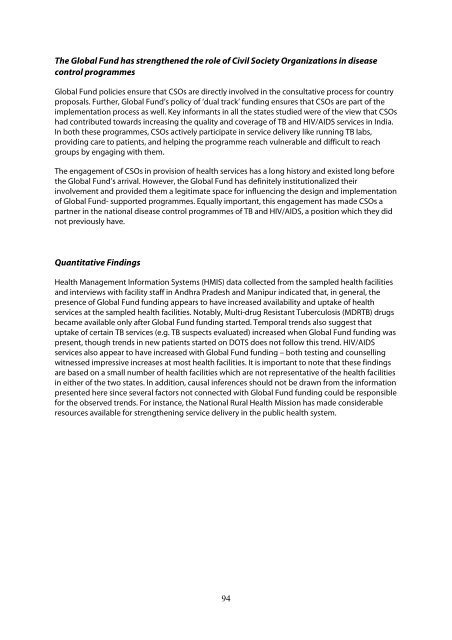MAXIMIZING POSITIVE SYNERGIES - World Health Organization
MAXIMIZING POSITIVE SYNERGIES - World Health Organization
MAXIMIZING POSITIVE SYNERGIES - World Health Organization
Create successful ePaper yourself
Turn your PDF publications into a flip-book with our unique Google optimized e-Paper software.
The Global Fund has strengthened the role of Civil Society <strong>Organization</strong>s in disease<br />
control programmes<br />
Global Fund policies ensure that CSOs are directly involved in the consultative process for country<br />
proposals. Further, Global Fund’s policy of ‘dual track’ funding ensures that CSOs are part of the<br />
implementation process as well. Key informants in all the states studied were of the view that CSOs<br />
had contributed towards increasing the quality and coverage of TB and HIV/AIDS services in India.<br />
In both these programmes, CSOs actively participate in service delivery like running TB labs,<br />
providing care to patients, and helping the programme reach vulnerable and difficult to reach<br />
groups by engaging with them.<br />
The engagement of CSOs in provision of health services has a long history and existed long before<br />
the Global Fund’s arrival. However, the Global Fund has definitely institutionalized their<br />
involvement and provided them a legitimate space for influencing the design and implementation<br />
of Global Fund- supported programmes. Equally important, this engagement has made CSOs a<br />
partner in the national disease control programmes of TB and HIV/AIDS, a position which they did<br />
not previously have.<br />
Quantitative Findings<br />
<strong>Health</strong> Management Information Systems (HMIS) data collected from the sampled health facilities<br />
and interviews with facility staff in Andhra Pradesh and Manipur indicated that, in general, the<br />
presence of Global Fund funding appears to have increased availability and uptake of health<br />
services at the sampled health facilities. Notably, Multi-drug Resistant Tuberculosis (MDRTB) drugs<br />
became available only after Global Fund funding started. Temporal trends also suggest that<br />
uptake of certain TB services (e.g. TB suspects evaluated) increased when Global Fund funding was<br />
present, though trends in new patients started on DOTS does not follow this trend. HIV/AIDS<br />
services also appear to have increased with Global Fund funding – both testing and counselling<br />
witnessed impressive increases at most health facilities. It is important to note that these findings<br />
are based on a small number of health facilities which are not representative of the health facilities<br />
in either of the two states. In addition, causal inferences should not be drawn from the information<br />
presented here since several factors not connected with Global Fund funding could be responsible<br />
for the observed trends. For instance, the National Rural <strong>Health</strong> Mission has made considerable<br />
resources available for strengthening service delivery in the public health system.<br />
94

















